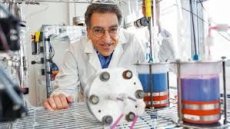New publications
A new type of organic battery has been developed in California
Last reviewed: 02.07.2025

All iLive content is medically reviewed or fact checked to ensure as much factual accuracy as possible.
We have strict sourcing guidelines and only link to reputable media sites, academic research institutions and, whenever possible, medically peer reviewed studies. Note that the numbers in parentheses ([1], [2], etc.) are clickable links to these studies.
If you feel that any of our content is inaccurate, out-of-date, or otherwise questionable, please select it and press Ctrl + Enter.

Specialists from the University of Southern California have developed an organic battery. According to scientists, their development is more durable and is made from cheap organic materials. The organic battery, unlike the usual one, does not contain toxic compounds and metal and is suitable for power plants. The new development will make the energy of the network more stable and will allow the creation of energy accumulation in huge volumes and subsequent use.
Professor of the University of Southern California Sri Narayan noted that the organic battery is capable of maintaining efficiency for up to five thousand recharge cycles, and according to preliminary estimates, its service life will be approximately fifteen years.
The efficiency of the lithium-ion batteries currently in use deteriorates significantly after about a thousand recharge cycles, and the cost of manufacturing such batteries is ten times higher. As the research group notes, organic batteries, due to their simplicity, low cost, reliability and environmental friendliness, will make a breakthrough in the field of energy storage. In addition, organic batteries can initiate a new stage in the use of alternative energy sources to best meet the energy needs of the population.
Solar panels only produce energy when the sun shines, just as all wind turbines only produce energy when the wind blows. Therefore, it is not profitable for energy companies to produce clean energy, since it is impossible to rely on sources such as the sun or wind to meet consumer demand.
Batteries that can accumulate and store energy and then release it will help solve the main problem of unreliability associated with alternative sources.
Currently, energy storage on a particularly large scale is the main problem. According to experts, renewable energy sources in the future will need inexpensive and environmentally friendly solutions.
The mechanism of action of the new organic battery is based on oxidation and reduction reactions. Solutions enter through a container separated by a membrane with electrodes, which in the process leads to the release of energy.
This solution has an advantage, since the power of the source does not depend on the capacity. Theoretically, containers with electroactive materials can be of any size and increase the total volume of the energy storage. In addition, it is possible to adjust the central cell and regulate the amount of energy produced per hour.
The research team focused on electroactive materials rather than the metal and toxic substances used in previous models. The scientists were tasked with finding an organic compound that could dissolve in water. The result was a system that has a low environmental impact and does not require a large investment.
In the course of numerous experiments, a group of specialists discovered that oxidized organic compounds – quinones, which are present in the tissues of some animals, bacteria, fungi and are necessary for photosynthesis and oxygen exchange, are ideal for the operation of an organic battery.
 [ 1 ]
[ 1 ]
